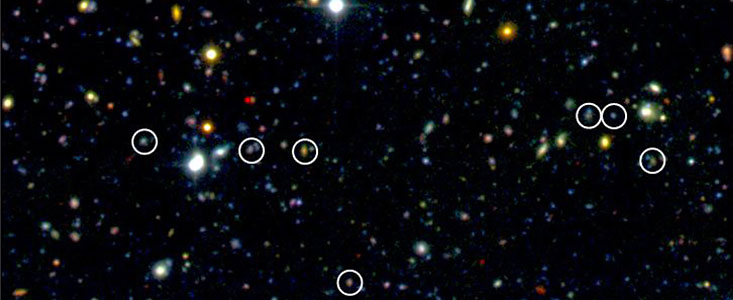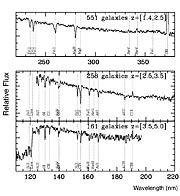Nota de prensa
A Cosmic Baby-Boom
Large Population of Galaxies Found in the Young Universe with ESO's VLT
22 de Septiembre de 2005
The Universe was a more fertile place soon after it was formed than has previously been suspected. A team of French and Italian astronomers [1] made indeed the surprising discovery of a large and unknown population of distant galaxies observed when the Universe was only 10 to 30% its present age.
This breakthrough is based on observations made with the Visible Multi-Object Spectrograph (VIMOS) as part of the VIMOS VLT Deep Survey (VVDS). The VVDS started early 2002 on Melipal, one of the 8.2-m telescopes of ESO's Very Large Telescope Array [2].
In a total sample of about 8,000 galaxies selected only on the basis of their observed brightness in red light, almost 1,000 bright and vigorously star forming galaxies were discovered that were formed between 9 and 12 billion years ago (i.e. about 1,500 to 4,500 million years after the Big Bang).
"To our surprise, says Olivier Le Fèvre, from the Laboratoire d'Astrophysique de Marseille (France) and co-leader of the VVDS project, "this is two to six times higher than had been found previously. These galaxies had been missed because previous surveys had selected objects in a much more restrictive manner than we did. And they did so to accommodate the much lower efficiency of the previous generation of instruments."
While observations and models have consistently indicated that the Universe had not yet formed many stars in the first billion years of cosmic time, the discovery announced today by scientists calls for a significant change in this picture. The astronomers indeed find that stars formed two to three times faster than previously estimated.
"These observations will demand a profound reassessment of our theories of the formation and evolution of galaxies in a changing Universe", says Gianpaolo Vettolani, the other co-leader of the VVDS project, working at INAF-IRA in Bologna (Italy).
These results are reported in the September 22 issue of the journal Nature (Le Fèvre et al., "A large population of galaxies 9 to 12 billion years back in the life of the Universe").
Notas
[1] The team of French and Italian researchers is co-led by Olivier Le Fèvre, director of the Laboratoire d'Astrophysique de Marseille (LAM) in France and by Gianpaolo Vettolani (INAF-IRA, Bologna) in Italy. It has been successful in the study of the history of galaxies from their formation early in the life of the Universe until the present epoch by combining fundamental research with the construction of specialized instruments uniquely suited to this task. The VIMOS (Visible Multi-Object Spectrograph) instrument has been designed using this team's expertise in instrument building, and was build by a French-Italian consortium financed by ESO, CNRS and the Provence-Alpes Côte d'Azur region in France, and by CNR, INAF and the Ministry of Education in Italy.
[2] With VIMOS, astronomers are able to measure the distances and the properties of up to 1,000 very distant galaxies in one single observation, and to complete in a few hours, observations that would have taken months only a few years ago. With capabilities up to ten times more productive than competing instruments, this instrument offers the possibility for the first time to conduct an unbiased census of the distant Universe. Using the high efficiency of the VIMOS instrument, the VVDS can thus "simply" observe, in a given patch of the sky, all galaxies brighter than magnitude 24 in the red, that is, galaxies that are up to 16 million times fainter than what the unaided eye can see. For each galaxy in this area, a spectrum is taken. From the measured redshift, the astronomers can determine the galaxy's distance.
Contactos
Olivier Le Fèvre
Laboratoire d'Astrophysique de Marseille
Marseille, France
Teléfono: +33 (0) 4 91 05 59 85
Correo electrónico: Olivier.LeFevre@oamp.fr
Acerca de la nota de prensa
| Nota de prensa No.: | eso0530 |
| Legacy ID: | PR 24/05 |
| Nombre: | VIMOS VLT Deep Survey |
| Tipo: | Early Universe : Cosmology : Morphology : Deep Field |
| Facility: | Very Large Telescope |
| Instruments: | VIMOS |
| Science data: | 2005Natur.437..519L |
Our use of Cookies
We use cookies that are essential for accessing our websites and using our services. We also use cookies to analyse, measure and improve our websites’ performance, to enable content sharing via social media and to display media content hosted on third-party platforms.
ESO Cookies Policy
The European Organisation for Astronomical Research in the Southern Hemisphere (ESO) is the pre-eminent intergovernmental science and technology organisation in astronomy. It carries out an ambitious programme focused on the design, construction and operation of powerful ground-based observing facilities for astronomy.
This Cookies Policy is intended to provide clarity by outlining the cookies used on the ESO public websites, their functions, the options you have for controlling them, and the ways you can contact us for additional details.
What are cookies?
Cookies are small pieces of data stored on your device by websites you visit. They serve various purposes, such as remembering login credentials and preferences and enhance your browsing experience.
Categories of cookies we use
Essential cookies (always active): These cookies are strictly necessary for the proper functioning of our website. Without these cookies, the website cannot operate correctly, and certain services, such as logging in or accessing secure areas, may not be available; because they are essential for the website’s operation, they cannot be disabled.
Functional Cookies: These cookies enhance your browsing experience by enabling additional features and personalization, such as remembering your preferences and settings. While not strictly necessary for the website to function, they improve usability and convenience; these cookies are only placed if you provide your consent.
Analytics cookies: These cookies collect information about how visitors interact with our website, such as which pages are visited most often and how users navigate the site. This data helps us improve website performance, optimize content, and enhance the user experience; these cookies are only placed if you provide your consent. We use the following analytics cookies.
Matomo Cookies:
This website uses Matomo (formerly Piwik), an open source software which enables the statistical analysis of website visits. Matomo uses cookies (text files) which are saved on your computer and which allow us to analyze how you use our website. The website user information generated by the cookies will only be saved on the servers of our IT Department. We use this information to analyze www.eso.org visits and to prepare reports on website activities. These data will not be disclosed to third parties.
On behalf of ESO, Matomo will use this information for the purpose of evaluating your use of the website, compiling reports on website activity and providing other services relating to website activity and internet usage.
Matomo cookies settings:
Additional Third-party cookies on ESO websites: some of our pages display content from external providers, e.g. YouTube.
Such third-party services are outside of ESO control and may, at any time, change their terms of service, use of cookies, etc.
YouTube: Some videos on the ESO website are embedded from ESO’s official YouTube channel. We have enabled YouTube’s privacy-enhanced mode, meaning that no cookies are set unless the user actively clicks on the video to play it. Additionally, in this mode, YouTube does not store any personally identifiable cookie data for embedded video playbacks. For more details, please refer to YouTube’s embedding videos information page.
Cookies can also be classified based on the following elements.
Regarding the domain, there are:
- First-party cookies, set by the website you are currently visiting. They are stored by the same domain that you are browsing and are used to enhance your experience on that site;
- Third-party cookies, set by a domain other than the one you are currently visiting.
As for their duration, cookies can be:
- Browser-session cookies, which are deleted when the user closes the browser;
- Stored cookies, which stay on the user's device for a predetermined period of time.
How to manage cookies
Cookie settings: You can modify your cookie choices for the ESO webpages at any time by clicking on the link Cookie settings at the bottom of any page.
In your browser: If you wish to delete cookies or instruct your browser to delete or block cookies by default, please visit the help pages of your browser:
Please be aware that if you delete or decline cookies, certain functionalities of our website may be not be available and your browsing experience may be affected.
You can set most browsers to prevent any cookies being placed on your device, but you may then have to manually adjust some preferences every time you visit a site/page. And some services and functionalities may not work properly at all (e.g. profile logging-in, shop check out).
Updates to the ESO Cookies Policy
The ESO Cookies Policy may be subject to future updates, which will be made available on this page.
Additional information
For any queries related to cookies, please contact: pdprATesoDOTorg.
As ESO public webpages are managed by our Department of Communication, your questions will be dealt with the support of the said Department.


